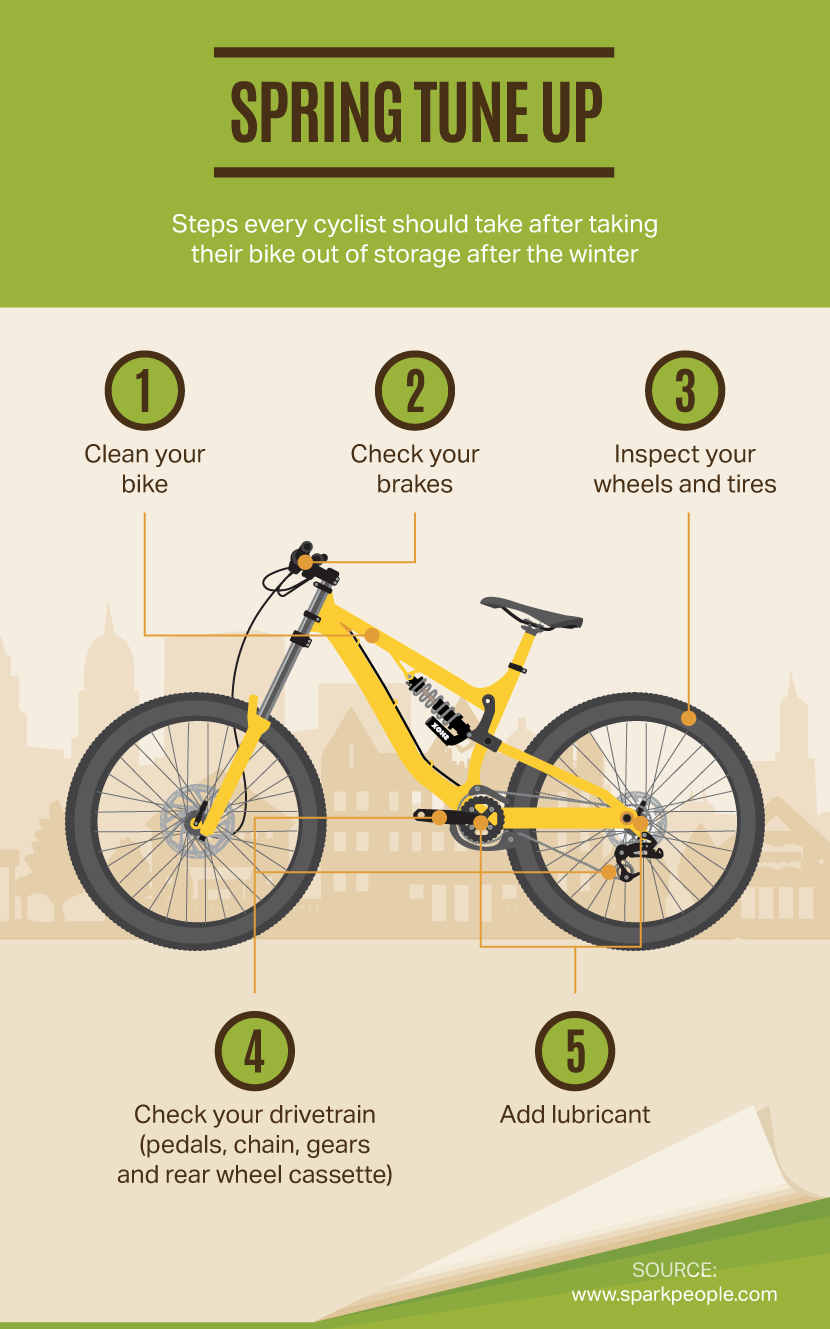
Get your fix of expert articles delivered straight to your inbox!
No Thanks - I don't like cool stuff

Cycling is no longer a fair-weather activity. More of us are using our bicycles for recreation and transportation all year, making it important to remember proper maintenance to ensure your ride is a smooth one regardless of the season. While maintaining your bicycle isn’t as complex as maintaining your car, there are things you need to do to ensure your bike remains in tip-top shape the entire year and gear to consider using to ensure you are comfortable on your bike in all types of weather.

While some ride all year, it’s not uncommon for many cyclists to store their bikes for winter and roll them out in spring. If you fall in that category, you’ll want to follow these steps before hopping back on the bike trail or road each spring.
First, you’ll want to clean your bike thoroughly with a simple cleaning agent such as Simple Green or Mrs. Meyers. Why? Getting that dust, mud, and grime off your bike allows you to inspect it thoroughly, and a clean bike will run better, just as a clean car does.
Next, check the brake pads, which are the rectangular rubberized components that rub against the metal tire rim. Using a flashlight or your cellphone light, check the pads for any uneven wear. You’ll need to replace the pads if they show excessive wear. Check your wheels for any wear and tear, and spin your rims, watching for any damage, wobbles, or spoke issues. Then inspect your tires for any tears, smooth patches of wear, or burrs stuck inside.
The drivetrain and cables are next. These are usually the most intimidating part of the bike for new cyclists. The drivetrain includes the bike pedals, chain, derailleur (which moves the chain to make riding easier or harder), and rear wheel cassette (the little teeth in the center of the rear wheel). Start by spinning the rear wheel like you did when checking the wheels and tires, shifting through the gears as you do so. Watch the chain, derailleur, and cassette for any issues such as missing teeth or scraping motions. If you notice any problems, you’ll want to take your bike to a repair shop for adjustments.
Finally, apply oil lubricant, coating the chain and other components of the drivetrain. Lube helps them last longer and work more smoothly and keeps dirt from accumulating.

Once you’re on the road, problems can certainly arise even with a well-tuned and maintained bike. Most commonly, your chain may drop, which luckily is easily fixed. Start by turning the bike upside down, then prepare to get your hands a little greasy. Note what gear you’re in by looking at your derailleur and then push the rear derailleur arm toward the handle bars to give yourself some slack. Slide the chain back on the right gear by picking up the chain and draping it on top of the appropriate gear. Slowly pedal with your hand, watching to make sure the chain is back on.
If you find yourself with a flat tire, which will definitely happen at some point, you’ll need to make sure you have a small bike pump and a patch kit with you or, even better, a spare tire. Remove the tire and then check it to find the source of the problem. It can help to blow it up to listen for a hiss. Clean the source of the tear with an alcohol swab and then apply your patch. Most patches are now glue-free, which means you just need to press them to the tire. Blow the tire back up so it has some shape, wrap it back around your wheel, and then finish pumping it up.
Sometimes a spoke will come loose, which can be a problem if it gets in the way of the brake pad or your leg. If this happens, remove it from the bike, as you can continue to ride without one spoke. If it won’t come loose, you may need to bend it and twist it around a neighboring spoke to keep it out of the way.

If you opt to ride in the winter months, be sure to have the proper gear. Most importantly for your safety, make sure you have the needed reflective gear for riding in the dark. The brightest options include clip-on LED lights that blink; these have the added benefit of being removable, allowing you to clip them to other bikes or even to yourself for running or walking in the dark. Traditional reflective strips also work, as well as stick-on adhesive strips.
Make sure you have cold-weather wear, including a hat that fits under your helmet (running or skiing beanies work well), long tights and cycling jackets, and perhaps an underlaying layer such as Merino wool or a wool blend. Gloves make the chilly commute more bearable as well.

If you do opt to store your bike in the winter, don’t put it away in the fall before going through the following steps to ensure it will be ready to hop on in the spring. Start by cleaning your bike thoroughly and then remove water bottles, GPS screens, and navigation tools. Inflate your tires to the correct pressure so they don’t develop bulges or flat spots during the winter. Lubricate the drivetrain and derailleur and then do yourself a favor and take your bike to a repair shop for a full tune up. Come spring, you’ll be very glad to have already done this task.
Written by:

Get your fix of expert articles delivered straight to your inbox!
No Thanks - I don't like cool stuff